- Home
- Jimmy Guieu
Polarian-Denebian War 4: Space Commandos Page 5
Polarian-Denebian War 4: Space Commandos Read online
Page 5
The Wolfian historian rolled around his pink eyes in his hairy face and with great wisdom concluded, “The inhabitants of T27, Zimko, are at a turning point in their evolution. They are anxious and fearful of another war far more devastating than what they seen before. They refuse to believe in what they call ‘flying saucers’… but they’re scared of them, perhaps subconsciously. The day will come, however, when they’ll have to recognize their mistake. This will be the day when they’ll understand that in spite of their racial and religious differences all men are brothers. It will be harder for them to admit that Centaurians and we Wolfians are also brothers, but that too will come in time… when the threat of the Denebians and Procyonians looming over the galaxy is finally cut off.”
CHAPTER IV
The space squadron commanded by Zimko split into two groups of 25 ships each. One of the groups led by Ruanoor, Chief of the Wolfian section, headed toward Mars. The second squadron, under Zimko’s command, flew off into the star-studded space toward Venus.
In his cockpit Ruanoor, with his four long, six-knuckled fingers resting on a star chart, was studying the cosmographic coordinates and the tables showing the shaded zones disrupted by the sun’s electrical storms. Next to him a Wolfian woman, Woodna, sat at the space radar carefully watching the three triangular screens of her detector.
Ruanoor put away his charts, adjusted some controls, tuned the electromagnetic cone of the detection beams to the polarity of Mars and leaned back, satisfied, in his bucket seat.
The luminous spiral that ran around the cockpit emanated a pinkish light, almost the same color as the Wolfian eyes when they feel no emotion. Because the color of their eyes changed according to their mood.
Faint traces of methane and ammonia gas produced by the air conditioning units appropriate for their race floated around the smooth chrome walls of the round room from time to time. Quickly dissipated by the combining with the nitrogen and carbon dioxide, these traces sometimes shined with a pink fluorescence when drifting in front of the spiral of the lighted rail.
The Wolfian watched the slow movement of a liquid metal “ball”, like purple mercury, that rolled in a clear, calibrated tube in the shape of a horizontal circle. His right oval eye popped out of its socket every once in a while and rolled over to see Woodna leaning over her screens. He watched her—with what the humans would call “love”—who had been his crew mate for many K’bogs. The Wolfian leaders, being good psychologists, from the start of their space treks, had understood very well the use and need of mixed crews. Far from their home planet the Wolfians who were temporarily exiled in space or on foreign planets could not live without the presence of the opposite sex. Wolfian women quickly proved themselves excellent radar operators. Moreover, because of their ethics and great wisdom Wolfians could live with these operators without succumbing to arousing passions—if their feelings were not mutual—that might cause emotional conflict.
Gentle and lacking the “tactical” tricks so frequent among Earthling women, and being aware of their two-fold mission as aides and Muses, by the very presence of a little poetry in the hearts of their companions, Wolfian women were proud of the role they played in this grand space age of their people.
Woodna was thinking about all this while the mental waves sent out from Ruanoor slowly entered her. The silky black down on her face bristled and quivered as if being petted when her mind caught the psychic thoughts and send their vibrating effects through her body. With taking her right eye off the three radar screens she popped out her left and turned it, with no pretended confusion, toward the pink eye that had been watching her longingly for a moment.
Ruanoor’s right eye and Woodna’s left eye abruptly turned emerald green, a sign of affection. In a perfect coordinated movement their arms reached out for each other and their long fingers caressed the part of their head that served as a neck, the seat of an erogenous zone. This weird “finger kiss” was abruptly interrupted. With their senses heightened, on alert, the two Wolfians seemed to be listening hard to an almost inaudible sound.
On the three radar screens a kind of shadow sometimes come out to cover the spiral of blinking light that served as a tracer.
“That’s weird,” Woodna said. “It’s like something just entered the detection field. According to the tracer it’s pretty big but it’s blurry… it even disappears sometimes. I can’t really say if it’s solid… or gas. There’s no echo to speak of being sent back by it but a kind of hazy interference.”
Ruanoor consulted a device under a vacuum jar in which a small bright sphere was emitting a violet light.
“I’m getting no magnetic disturbance that would explain the reactions of the radarscope… as far as these mysterious, ghostly shadows appearing very hazily off and on your screens can be called ‘echo reactions’.”
Turning on his viewer he tuned into the general communication wavelength to send a message to the whole squadron:
“Ruanoor to the teams of Commando MT3. Are you getting anything strange on your radar screens?”
The answers came back one by one following the customary order in communicating with the chief of the Commandos.
“In fact, we were about to contact you about the presence of an inexplicable ‘shadow’ on our space radar.”
“Since we don’t know the origin or nature of this ‘moving shadow’, stay on your guard and be ready to move at the first signal. Spread out to 100 diameters. That way, whatever happens, our squadron will be a lot less vulnerable to a would-be attacker. However, I don’t think it’s a real threat. If an enemy ship were operating in our zone it would have certainly been detected already. This mysterious shadow isn’t precise enough to call it a material body. Maybe it’s a cloud of cosmic dust composed of pyrite or some other magnetic material.”
The 25 spaceships spread out, still keeping a triangular formation but putting 600 yards between each other. Ruanoor and Woodna kept one eye on the three triangular screens while lost in thought about the cause and origin of this shadow detected by all the ships.
They both felt a peculiar sensation. It was not awkwardness, at most a discomfort, a kind of odd unrest that was slowly wiping out their ability to think straight. The flight controls seemed to stretch away from them only to shoot back to their normal place before the cycle started up again: slowly stretch away and suddenly shoot back. But every time the commands came back into clear view a little more slowly. Finally their vision fogged over and they saw nothing but a hazy, impalpable mist that drowned everything in the moving shadow of “something” present and yet unseen.
“Woodna! Woodna!” Ruanoor struggled to call out.
“Your voice is… so far away,” the Wolfian girl managed to sigh out before being frozen in her chair with her head thrown back.
In a last effort of will Ruanoor flipped on the general alarm, instantly putting him in contact with the rest of the commando.
“We’re suffering… some… psycho-physical malaise,” he murmured. “Take… our ship… under control… of your…”
He could not finish as he completely stopped thinking. Stiff, staring at the controls and obeying an unknown mental order, he slowly turned a small sphere that opened the ventral hatch of his spaceship. After a minute the small sphere returned to its normal position, thus showing that the exterior hatch had been closed by someone from the inside!
Protected by a screen that absorbed almost all detecting rays emitted by the 25 Fimn’has, which it had been following for almost an hour, a giant, disc-shaped Denebian vessel was fearlessly navigating the velvety darkness of space. Its impressive size would only appear as a vague shadow on the Wolfian radar. And the dwarfish crew would be unable to discover the origin of this weird “ghost” in the middle of their triangular screens.
Now, in a 600-mile radius, the enemy ship was sending out beams of hypnotic waves to annihilate the wills of the astronauts piloting the Fimn’has.
After sending psychic orders to the Wolfians to open the
hatch of all their ships, M’nag, the Denebian Chief of the huge, lenticular ship with a dome on top, ordered the boarding while P’tonk, his second-in-command, took the helm.
The giant spaceship had just synchronized its speed with the 25 Fimn’has and was keeping at least 1,000 yards over the tight formation. Under its belly a long, reinforced door panel opened where 50 Denebians were standing in transparent spacesuits that revealed their repulsive, scaly green, humanoid bodies. Their green heads were encased in rectangular helmets. Their bumpy skulls were topped by a blood-red, fleshy growth. Their beady eyes, always moving, were orange with vertical black stripes. Inside their spacesuits all they wore was a yellow-orange jacket and black bodysuit with a belt from which hung a long tube that shot thermal rays.
With a bending at the knees the 50 Denebians leaped into space, turning on their jet packs in order to escape the pull of their giant spaceship and especially so as not to drift off into outer space. Like birds of prey they spread out in pairs and slowed down when they finally had to grab onto the open bellies of the Fimn’has with their magnetic grappling gloves. With short bursts of their jet packs, using their hands and feet, they slipped in through the narrow hatches of the flying saucers before closing them up behind them.
When all of them had disappeared inside the Wolfian and Centaurian discs, the giant spaceship shot off at incredible speed to the swarm of asteroids (between the orbits of Mars and Jupiter), one of which contained their base.
M’nag, the Denebian Chief of the spaceship and P’tonk, his second-in-command, a specialist in attacking the Space Commandos of the Federated Worlds in this solar system, opened the interior hatch of the Wolfian ship where they had entered. Bent over in the narrow cabin of the Fimn’has—made for Wolfians only four feet tall and not these six and half feet tall hideous monsters—they struggled out of their spacesuits.
Being sympodic creatures able to adapt to all environments and thus breathing the methane and ammoniac air as easily as their own full of cyanogen, they could, therefore, take off their suits to have more freedom of movement.
Both of them folded up their spacesuits, put them to the side and sat on the floor, their backs against the chrome metal wall of the cockpit. Then they slowly ran their horny fingers over a small machine with different colored “bumps” that was installed in their belts. And they waited.
Ruanoor and Woodna, the one slumped over the control panel and the other leaning back in the pilot’s seat, started moving. They shook themselves, their big eyes fluttering in their sockets and their shiny black fur bristling. With their backs to the Denebians they were not yet aware of their presence.
“What made us pass out?” Ruanoor mumbled as he examined the instruments.
“I feel like I’m waking up from a very long sleep,” Woodna confessed. “The astronavigator says that we’re at least six million miles from Mars. It read 15 million just before we were knocked out by… the loss of consciousness. We couldn’t have been out for more than ten minutes.”
“In seven minutes T27 time we’ll reach Mars and get in touch right away with our home planet to tell the cosmobiologists about the symptoms of this weird psychic-physical attack.”
“You’ll say nothing of the kind.”
At these words the two Wolfians jumped in surprise and turned around. M’nag, who had just spoken, was pointing his thermal ray tube at them. His sidekick was also gripping his menacing weapon in his claws.
“You’re at our mercy,” M’nag’s guttural voice said in the universal language. “In all of your ships there are two of us. The slightest false movement or any attempt to escape or alert your planetary base will get you fried. Keep heading toward Mars. At the appropriate time we will give you specific orders.”
Zimko’s squadron descended slowly through the thick atmosphere of Venus, guided only by radar. Piloting was always done like this on Venus where there was no visibility until 10,000 feet altitude. Above this a dense cushion of atmosphere, ten and a half miles thick, barred all normal, sight-based flight. On Venus no eye could contemplate the stars. The rays of the sun, in spite of the relative proximity13, barely reached the surface. If “evolved” Venusians did exist, they would have been incapable (like the first Wolfians) of imagining the presence of other worlds in outer space.
Zimko veered off course slightly. His viewing radar was showing a tall chain of mountains. The ship gained altitude, flew over the rocky range and came back down into a wide valley where the permanent base stood.
Under the thick, cloudy layer of cottony fog rose up the Polarian city’s dull dome, not sparkling in the sunlight filtered by the Venusian gas. It was the middle of the day on this hemisphere but it was nothing like a sunny day on Earth. Stifling heat lay outside the dome that sheltered a pyramidal city that looked exactly like the one on the Moon. Strange plants and enormous trees, flowers like huge umbrellas, vines as thick as tree trunks and hundreds of feet long, all tangled in the tropical atmosphere that was saturated with carbon dioxide. Ironically, although this gas made up a large part of Venus’ atmosphere, it became much rarer under 10,000 feet down to the surface, in spite of the density that normally should have trapped it on the ground, especially in the valleys.
This particularity had allowed a kind of life to adapt to these physical conditions. Although unbreathable for Polarians and humans, the air on Venus maintained the life of a category of rudimentary thinking beings. Anthropologists and paleontologists on Earth would have called them “pre-hominid” or maybe even “hominid”—“spiritually” speaking—in the first stage of mental evolution. But all comparison would stop there. The morphology of the Venusians was radically different from Polarians and their human characteristics.
For millennia the so-called “Men from Outer Space” had tried to educate this race of half-insect, half-biped creatures with their gangly bodies like a praying mantis, three pairs of “arms” and two long legs with yellow thighs protected by serrated spikes. They had gotten satisfactory results after a few generations but, alas, as soon as their influence stopped the Venusians left to themselves returned to their natural state and forgot all the teaching. Therefore, they had to live in permanent contact with the Polarians.
For 15 years, starting from the reestablishment of a fixed base, many Venusians had started “to think” intelligently again with more or less success.
The 25 flying saucers landed gently not far from the dome and the mixed crews—Polarians, Wolfians and Centaurians—came out in their spacesuits.
“It’s weird,” Zimko said to his friend Tim’hu, a wise old Wolfian. “I don’t see any life in the city.”
Standing absolutely still he concentrated and used his paroptic vision. All of a sudden his face tensed and he clenched his jaw.
“The people on the base are unconscious and most of them are probably dead! The ones still alive are unable to think. Their psyches are slowed down to the utmost limit of perception. It’s impossible to tell what happened to them. Let’s go. I don’t see any foreign presence under the…”
He broke off, then cried out, “I just saw a series of huge cracks in the protective dome. The artificial air has escaped and been replaced by the Venusian gas… That explains why everyone is either dead or in a coma.”
He sent out orders: three groups of Wolfians and Centaurians would put on their spacesuits to bring out various strange instruments that acted as both metal tanks of compressed air and submachine guns.
As fast as their freezing legs allowed they would all run to one of the three cracks indicated by Zimko. The first crack they came across measured at least three feet wide and 20 feet long. In the blink of an eye the “dwarves” put their material on the ground, took out a long flexible tube that they changed into an instrument resembling a submachine gun and they pointed the “barrel” at one end of the giant crack.
A strong jet of fluid spread over the angular crack that puffed and swelled noticeably. On the other side of the crack another team of small creatures
in spacesuits did the same thing. The liquid jet spread quickly from one end to the other of the break changed into an opaque, bulbous material that swelled and hardened almost instantly. In less than three minutes the two “lips” of the crack closed up and bonded tightly. The Wolfians and Centaurians sprayed their quick-set “mending” with one last air-tight layer and hurried back to their spaceships where they put away their tools.
While the cracks were being sealed, Zimko along with three Polarians, four Wolfians and two Centaurians ran through the eerily silent city. The Polarians, being faster than their dwarfish companions, were the first to reach a 30-foot square, super-metal building. The Chief of the Space Commandos halted, surprised that the armored door of the “block” was open.
His paroptic vision assured him that no hostile presence was inside. He and his team entered the cube with lighted walls and immediately turned on six huge wall switches while the two Wolfians, crouching on their short legs, turned a big, calibrated wheel. At their feet, in front of the controls that they had just worked, lay a Polarian with his chest and head burned.

 Polarian-Denebian War 6: Prisoners of the Past
Polarian-Denebian War 6: Prisoners of the Past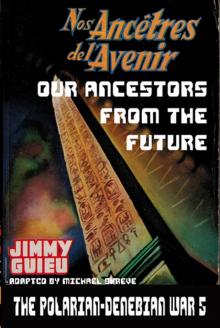 Polarian-Denebian War 5: Our Ancestors From the Future
Polarian-Denebian War 5: Our Ancestors From the Future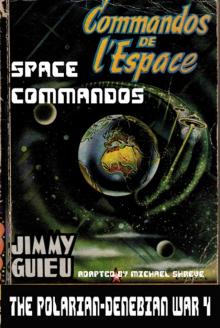 Polarian-Denebian War 4: Space Commandos
Polarian-Denebian War 4: Space Commandos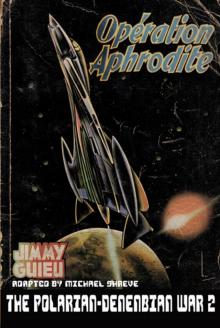 Polarian-Denebian War 2: Operation Aphrodite
Polarian-Denebian War 2: Operation Aphrodite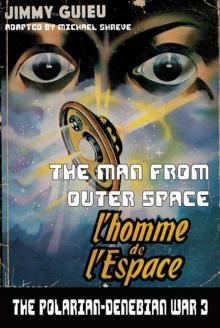 Polarian-Denebian War 3: The Man From Outer Space
Polarian-Denebian War 3: The Man From Outer Space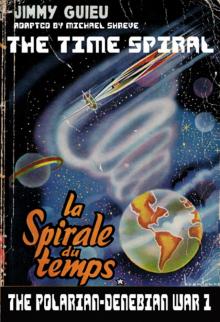 Polarian-Denebian War 1: The Time Spiral
Polarian-Denebian War 1: The Time Spiral